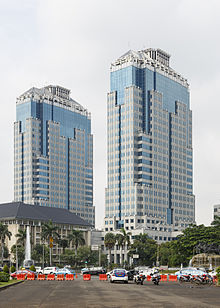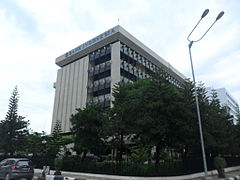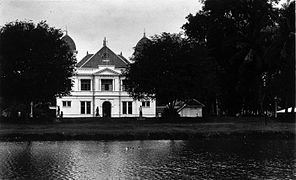  Bank Indonesia headquarters in Jakarta | |
| Headquarters | Jakarta, Indonesia |
|---|---|
| Established | 24 January 1828; 196 years ago (1828-01-24) (Bank of Java) 1 July 1953; 71 years ago (1953-07-01) (current form) |
| Governor | Perry Warjiyo |
| Central bank of | Indonesia |
| Currency | Indonesian rupiah IDR (ISO 4217) |
| Reserves | USD 136.4 billion |
| Website | bi |
Bank Indonesia (BI) is the central bank of the Republic of Indonesia. It replaced in 1953 the Bank of Java (Dutch: De Javasche Bank, DJB), which had been created in 1828 to serve the financial needs of the Dutch East Indies.
History
Bank of Java
Main article: Bank of JavaKing William I of the Netherlands granted the right to create a private bank in the Indies in 1826, which was named De Javasche Bank. It was founded on 24 January 1828 and later became the bank of issue of the Dutch East Indies. The bank regulated and issued the Netherlands Indies gulden.
In 1881, an office of the Bank of Java was opened in Amsterdam. Later followed the opening of an office in New York. By 1930 the bank owned sixteen office branches in the Dutch East Indies: Bandung, Cirebon, Semarang, Yogyakarta, Surakarta, Surabaya, Malang, Kediri, Banda Aceh, Medan, Padang, Palembang, Banjarmasin, Pontianak, Makassar, and Manado.
The Bank of Java was operated as a private bank and individuals as well as industries etc. could get help in the bank's offices.
-
 Head office of the Bank of Java in Batavia, now Museum Bank Indonesia in Jakarta
Head office of the Bank of Java in Batavia, now Museum Bank Indonesia in Jakarta
-
 Keizersgracht 666-668, former office of the Bank of Java in Amsterdam
Keizersgracht 666-668, former office of the Bank of Java in Amsterdam
-
 Branch of De Javasche Bank in Bandung, built in 1918; now a museum
Branch of De Javasche Bank in Bandung, built in 1918; now a museum
Bank Indonesia
Bank Indonesia was founded on 1 July 1953 from the nationalisation of De Javasche Bank, three years after the recognition of Indonesia's independence by Netherlands.
For the next 15 years, Bank Indonesia carried on commercial activities as well as acting as the nation's national bank and is in charge in issuing Indonesian rupiah currency. This came to an end with the Act No. 13 of 1968 on the Central Bank, transforming Bank Indonesia as a central bank.
The act was subsequently replaced by Act No. 23 of 1999, giving the bank independence from governmental control. Thereafter, the bank reported to the parliament (DPR) instead of the President, and the bank's governor was no longer a member of the cabinet.
Organization
The bank is led by the board of governors, comprising the governor, a senior deputy governor and at between four and seven deputy governors.
The governor and deputy governors serve a five-year term, and are eligible for re-election for a maximum of three terms. The governor and senior deputy governor are nominated and appointed by the president, with approval from the DPR. Deputy governors are nominated by the governor and appointed by the president, with approval of the DPR. The president has no power to dismiss a member of the board, except when a board member voluntarily resigns, is permanently disabled, or is proven guilty of criminal offence. The senior deputy governor acts as governor in the case of the latter's office vacancy.
The Board of Governors Meeting is the bank's highest decision-making forum. It is held at least once a month to decide on general policy on monetary affairs, and at least once a week to evaluate policy implementation or to decide on other strategic and principle policy.
The Bank is active in promoting financial inclusion policy and is a member of the Alliance for Financial Inclusion. It hosted AFI's second annual Global Policy Forum (GPF) in Bali, Indonesia in 2010. On 14 May 2012 Bank Indonesia announced it would be making specific commitments to financial inclusion under the Maya Declaration.
By 30 December 2013, the bank's microprudential supervision functions will be transferred to Financial Services Authority (OJK). In the future, the bank will maintain Indonesian financial system and monetary stability through mixture of monetary and macroprudential instruments and policies. The Financial Services Authority institutive law (law n° 21 of 2011 enacted on 31 December 2012) followed the US$710 million baylout of Bank Century and the receivership 21 other national private banks.
Strategic objectives
The Bank describes its strategic objectives as being:
- Maintain monetary stability
- Maintain the financial sustainability of the Bank of Indonesia
- Strengthen the effectiveness of monetary management
- Create a sound and effective banking system and financial system stability
- Maintain the security and effectiveness of the payment system
- Increase the effectiveness of Good Governance implementation
- Strengthen the organisation and build highly competent human resources with the support of a knowledge-based work culture
- Integrate the Bank of Indonesia's transformation in line with Bank Indonesia's destination statement of 2008
National Payment Gateway
The aim is to integrate all Automated Teller Machines in ASEAN countries, beginning with integration first in each country. On 16 January 2012 interconnection between Bank Mandiri ATMs and Bank Central Asia ATMs (Prima ATMs) was launched.
Bank Indonesia Liquidity Support
Bank Indonesia Liquidity Support is an Indonesian government policy that was formulated with Bank Indonesia in the crisis period and executed by Bank Indonesia to rescue the monetary and banking system as well as the economy as a whole. It was partly based on the instruction and command of the President in the limited meeting of economic, finance, and development supervision and production and distribution on 3 September 1997.
This policy was provided under various emergency lending schemes (Fasilitas Diskonto I/Fasdis I, Fasdis II, Fasilitas SBPU, Fasilitas SBPUK, Fasilitas Diskonto Baru and Dana Talangan).
Project Nexus
The Bank for International Settlements signed an agreement with Central Bank of Malaysia, Bank of Thailand, Bangko Sentral ng Pilipinas, Monetary Authority of Singapore, and the Reserve Bank of India on 30 June 2024 as founding member of Project Nexus, a multilateral international initiative to enable retail cross-border payments. Bank Indonesia involved as a special observer. The platform, which is expected to go live by 2026, will interlink domestic fast payment systems of the member countries.
Offices
BI operates 37 offices across Indonesia, and five representative offices in New York City, London, Tokyo, Singapore and Beijing. In addition, Bank Indonesia also operates several museums housed in the former De Javasche Bank office buildings, such as Jakarta (located in the former De Javasche Bank head office building in old Jakarta), Surabaya, and Padang.
Indonesian offices
Bank Indonesia have branches in almost all major cities of Indonesia.
-
 Bank Indonesia in Medan
Bank Indonesia in Medan
-
 Bank Indonesia in Banjarmasin
Bank Indonesia in Banjarmasin
-
 Bank Indonesia in Surakarta
Bank Indonesia in Surakarta
-
 Bank Indonesia in Yogyakarta
Bank Indonesia in Yogyakarta
-
Bank Indonesia in Padang
-
 Bank Indonesia in Palembang (1950s)
Bank Indonesia in Palembang (1950s)
-
 Town Hall and Bank Indonesia in Medan (formerly De Javasche Bank)
Town Hall and Bank Indonesia in Medan (formerly De Javasche Bank)
-
 De Javasche Bank in Surabaya
De Javasche Bank in Surabaya
-
 De Javasche Bank in Malang
De Javasche Bank in Malang
-
 De Javasche Bank in Banda Aceh
De Javasche Bank in Banda Aceh
Worldwide representative offices
 Singapore: 160 Robinson Road #28-05, SBF Center Singapore 068914.
Singapore: 160 Robinson Road #28-05, SBF Center Singapore 068914. London: 10 City Road, London EC 1Y 2EH.
London: 10 City Road, London EC 1Y 2EH. Tokyo: New Kokusai Building Room 906 No.4 - 1, Marunouchi 3 - Chome Chiyoda-ku, Tokyo, 100-0005 Japan.
Tokyo: New Kokusai Building Room 906 No.4 - 1, Marunouchi 3 - Chome Chiyoda-ku, Tokyo, 100-0005 Japan. New York: 200 Vesey Street 25th Floor New York 10285.
New York: 200 Vesey Street 25th Floor New York 10285. Beijing: Fortune Financial Center Building Lt. 46, 5 Dongsanhuan Road, Chaoyang District, Beijing 100020.
Beijing: Fortune Financial Center Building Lt. 46, 5 Dongsanhuan Road, Chaoyang District, Beijing 100020.
List of governors
| Name | Period |
|---|---|
| Sjafruddin Prawiranegara | 1953–1958 |
| Lukman Hakim | 1958–1959 |
| Soetikno Slamet | 1959–1960 |
| Soemarno | 1960–1963 |
| Jusuf Muda Dalam | 1963–1966 |
| Radius Prawiro | 1966–1973 |
| Rachmat Saleh | 1973–1983 |
| Arifin Siregar | 1983–1988 |
| Adrianus Mooy | 1988–1993 |
| J. Soedradjad Djiwandono | 1993–1998 |
| Syahril Sabirin | 1998–2003 |
| Burhanuddin Abdullah | 2003–2008 |
| Boediono | 2008–2010 |
| Darmin Nasution | 2010–2013 |
| Agus Martowardojo | 2013–2018 |
| Perry Warjiyo | 2018–present |
Bibliography
- J. Soedradjad Djiwandono. 2005. Bank Indonesia and the Crisis: An Insider's View. Singapore: Institute of Southeast Asian Studies. ISBN 978-981-230-308-0
- Miranda S. Goeltom. 2008. Essays in Macroeconomic Policy: The Indonesian Experience. Jakarta: PT. Gramedia Pustaka Utama. ISBN 978-979-22-3339-1
See also
- Economy of Indonesia
- Indonesian rupiah
- List of banks in Indonesia
- Payment system
- Real-time gross settlement
- Netherlands Trading Company
- Nederlandsch-Indische Handelsbank
- List of central banks
References
- Purnomo, Herdaru. "Top! Perry Warjiyo Jadi Gubernur of The Year se-Asia Pasifik". CNBC Indonesia. Retrieved 17 May 2020.
- "Monetary Indicators". Bank of Indonesia. Retrieved 20 July 2022.
- Dirk Teeuwen, no date. Javasche Bank, the Old Dutch City Hospital of Batavia-Jakarta and the Mandiri Bank Museum.
- Brief useful notes on the history of Bank Indonesia for various periods since 1953 are on the Bank Indonesia website at "History of Bank Indonesia Institution". See also Cribb, Robert & Kahin, Audrey (2004). Historical Dictionary of Indonesia. Historical dictionaries of Asia, Oceania, and the Middle East (2nd ed.). Lanham, MD: Scarecrow Press. pp. 45–46. ISBN 978-0-8108-4935-8.
- "Perry Warjiyo embarks on second term as BI governor". The Jakarta Post. Retrieved 4 June 2023.
- "GPF 2010 | AFI Global". afi-global.org. 20 February 2012. Archived from the original on 20 February 2012.
- John Berthelsen (12 November 2015). "Indonesia's Bank Century Mess Goes Global".
- "Mission and Vision". Bank Indonesia. Archived from the original on 15 June 2008.
- "Senin, ATM BCA dan Mandiri Resmi Terkoneksi". beritasatu.com.
- Kawale, Ajinkya (1 July 2024). "RBI, four Asean countries tie up for cross-border payments platform". Business Standard. Retrieved 2 July 2024.
- "MASNET". mas.gov.sg. Archived from the original on 1 August 2013. Retrieved 7 July 2015.
- "New York Bank Indonesia Representative Office". bi.go.id. Retrieved 19 April 2023.
External links
- Bank Indonesia official website Archived 11 December 2020 at the Wayback Machine
| Economy of Indonesia | |
|---|---|
| History | |
| Currency | |
| Banking and finance | |
| Ministries and agencies | |
| Industries | |
| Central banks | |
|---|---|
| Global | |
| Policies | |
| Implementation | |
| Bretton Woods system | |
| Lists | |
6°10′54″S 106°49′17″E / 6.18167°S 106.82139°E / -6.18167; 106.82139
Categories: